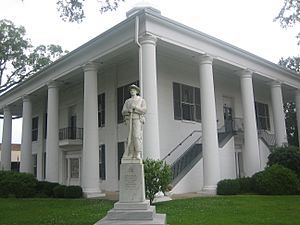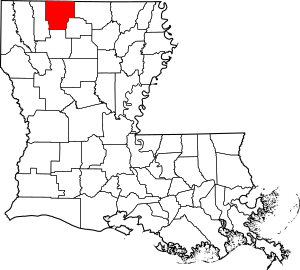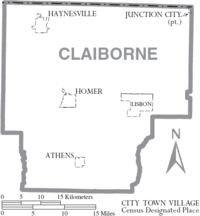Claiborne Parish, Louisiana facts for kids
Quick facts for kids
Claiborne Parish, Louisiana
|
|
|---|---|

The Claiborne Parish Courthouse was built in 1860 in Greek style. It served as a point of departure for Confederate troops.
|
|

Location within the U.S. state of Louisiana
|
|

Louisiana's location within the U.S.
|
|
| Country | |
| State | |
| Region | North Louisiana |
| Founded | March 15, 1828 |
| Named for | William C. C. Claiborne |
| Parish seat | Homer |
| Largest municipality | Lisbon (area) Homer (population) |
| Area | |
| • Total | 1,990 km2 (767 sq mi) |
| • Land | 1,960 km2 (755 sq mi) |
| • Water | 30 km2 (13 sq mi) |
| • percentage | 4 km2 (1.6 sq mi) |
| Population
(2020)
|
|
| • Total | 14,170 |
| • Estimate
(2021)
|
14,038 |
| • Density | 7.133/km2 (18.475/sq mi) |
| Time zone | UTC-6 (CST) |
| • Summer (DST) | UTC-5 (CDT) |
| Area code | 318 |
| Congressional district | 4th |
Claiborne Parish is a special kind of county called a parish in the northwestern part of Louisiana. It was created in 1828 and got its name from William C. C. Claiborne, who was the very first governor of Louisiana. In 2020, about 14,170 people lived here. The main town, where the parish government is located, is Homer.
Contents
History of Claiborne Parish
The first non-native family to settle in Claiborne Parish was the Murrell family, who moved from Arkansas in 1818. They settled near what is now Homer. Their home became a central spot, serving as a church, school, and even a post office for the growing community.
When Claiborne Parish was officially formed in 1828, the Murrell house was used for all government business, including court meetings. Later, the parish government chose Russellville as the main town. But as more people moved to the western part of the parish, the main town was moved to Overton in 1836. This was because Overton was at the start of the Dorcheat Bayou, which was important for travel by boat.
However, Overton had problems with flooding and health issues. So, in 1846, the main town moved again to Athens. But a fire in 1848 destroyed the courthouse and all its important papers. After that, the leaders of Claiborne Parish chose the current location for the main town, which became known as Homer.
You can learn more about the history of the area at the Herbert S. Ford Memorial Museum in Homer.
Exploring Claiborne Parish Geography
Claiborne Parish covers a total area of about 767 square miles. Most of this is land (755 square miles), and a smaller part (13 square miles) is water, like lakes and rivers.
Main Roads in the Parish
These are some of the important roads that run through Claiborne Parish:
 Future Interstate 69
Future Interstate 69 U.S. Highway 79
U.S. Highway 79 Louisiana Highway 2
Louisiana Highway 2 Louisiana Highway 9
Louisiana Highway 9
Neighboring Parishes and Counties
Claiborne Parish shares borders with several other parishes and counties:
- Columbia County, Arkansas (to the northwest)
- Union County, Arkansas (to the northeast)
- Union Parish (to the east)
- Lincoln Parish (to the southeast)
- Bienville Parish (to the south)
- Webster Parish (to the west)
Protected Natural Areas
Part of the Kisatchie National Forest is located within Claiborne Parish. This is a large forest area that helps protect nature.
Towns and Villages in Claiborne Parish
Claiborne Parish has several communities, including towns, villages, and smaller unincorporated areas.
Towns
- Haynesville
- Homer (This is the main town and the largest one by population.)
Villages
Unincorporated Communities
These are smaller communities that are not officially towns or villages:
- Arizona
- Colquitt
- Lake Claiborne
- Marsalis
- Russellville
- Sugar Creek
- Summerfield
- Weldon
Population and People
| Historical population | |||
|---|---|---|---|
| Census | Pop. | %± | |
| 1830 | 1,764 | — | |
| 1840 | 6,185 | 250.6% | |
| 1850 | 7,471 | 20.8% | |
| 1860 | 16,848 | 125.5% | |
| 1870 | 20,240 | 20.1% | |
| 1880 | 18,837 | −6.9% | |
| 1890 | 23,312 | 23.8% | |
| 1900 | 23,029 | −1.2% | |
| 1910 | 25,050 | 8.8% | |
| 1920 | 27,885 | 11.3% | |
| 1930 | 32,285 | 15.8% | |
| 1940 | 29,855 | −7.5% | |
| 1950 | 25,063 | −16.1% | |
| 1960 | 19,407 | −22.6% | |
| 1970 | 17,024 | −12.3% | |
| 1980 | 17,095 | 0.4% | |
| 1990 | 17,405 | 1.8% | |
| 2000 | 16,851 | −3.2% | |
| 2010 | 17,195 | 2.0% | |
| 2020 | 14,170 | −17.6% | |
| 2021 (est.) | 14,038 | −18.4% | |
| U.S. Decennial Census 1790-1960 1900-1990 1990-2000 2010-2013 |
|||
The population of Claiborne Parish has changed a lot over the years. In 1830, there were only 1,764 people. The population grew steadily, reaching its highest point in 1930 with 32,285 people. Since then, the population has generally decreased.
In 2020, the census counted 14,170 people living in the parish. These people lived in 5,917 households, with 3,718 being families.
Here's a look at the different groups of people living in Claiborne Parish in 2020:
| Race | Number | Percentage |
|---|---|---|
| White (non-Hispanic) | 7,064 | 49.85% |
| Black or African American (non-Hispanic) | 6,138 | 43.32% |
| Native American | 43 | 0.3% |
| Asian | 42 | 0.3% |
| Other/Mixed | 404 | 2.85% |
| Hispanic or Latino | 479 | 3.38% |
Learning in Claiborne Parish
The Claiborne Parish School Board is in charge of public schools throughout the entire parish. There is also a private school called Claiborne Academy, located near Haynesville.
Famous People from Claiborne Parish
Many interesting people have lived in or come from Claiborne Parish:
- Henry Walton Bibb: An American author and activist who worked to end slavery. He lived here from 1839 to 1841.
- T. H. Harris: He was the state superintendent of education for Louisiana for many years, from 1908 to 1940.
- Joe LeSage: A state senator from Shreveport who was born in Homer.
- George H. Mahon: He was a U.S. Representative, meaning he served in the national government.
- Dave L. Pearce: He served as the Louisiana Commissioner of Agriculture and Forestry for several terms.
- Richard Stalder: He was the secretary for the Louisiana Department of Public Safety and Corrections.
- David Wade: A Lieutenant General in the United States Air Force.
- Mule Watson: A professional baseball pitcher who played in Major League Baseball from 1918 to 1924.
- Patrick Floyd Garrett: A sheriff famous for being the person who ended the life of the outlaw Billy the Kid.
Images for kids
-
The Port-au-Prince Restaurant on Louisiana Highway 146 at Lake Claiborne.
-
Rolled hay in a farm field north of Athens (May 2010)
-
Holly Springs Baptist Church west of Homer on U.S. Highway 79
See also
 In Spanish: Parroquia de Claiborne para niños
In Spanish: Parroquia de Claiborne para niños









